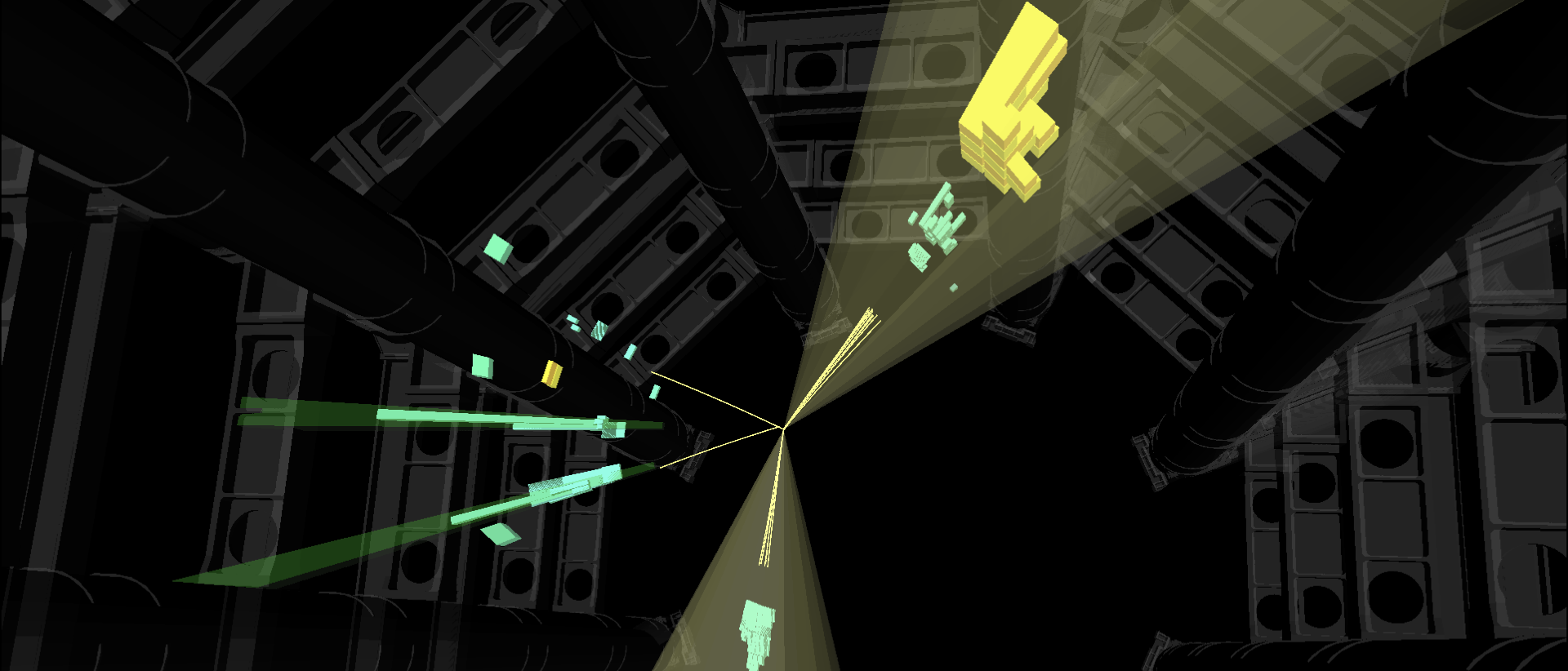Shining light on the strong interaction: ATLAS measures photon pair production
22 July 2021 | By
What can particles of light – photons – tell us about the inner workings of the Standard Model? A new paper from the ATLAS Collaboration measures pairs of photons to improve the understanding of a fundamental force of Nature – the strong force – and thus scrutinise the theoretical models that underpin high-energy physics research.
The Large Hadron Collider (LHC) smashes protons together to explore elementary particles and their interactions. Protons are composed of quarks, whose interactions are dominated by the strong force. Hence, any study of LHC data necessitates a good understanding of strong interactions.

Like all charged particles, quarks radiate photons. When LHC protons collide, these photons can be measured in the ATLAS detector – giving physicists insight into other particles produced by strong interactions during the same collision. As ATLAS can measure photons more precisely than these other particles, this approach is an excellent way to probe the strong force.
The ATLAS Collaboration’s newest paper examines the properties of photon pairs produced in LHC collisions. In particular, physicists measured the distribution of the transverse momentum of photon pairs. This is the sum of the two photon momenta in the plane perpendicular to the proton beams (the transverse plane, see Figure 1). The total transverse momentum before each proton–proton collision in ATLAS is zero. According to the law of momentum conservation, the total transverse momentum after each collision should also be zero. Should the photon pair’s transverse momentum differ from zero, then additional particles – such as quarks and gluons – could also be present in the collision event. These particles would have total transverse momentum equivalent but opposite to that of the photon pair.
ATLAS physicists are studying photons – particles of light – produced in LHC collisions to gain new insight into the strong force.

ATLAS’ new measurement is shown in Figure 2. Most of the measured photon pairs (black points) have low values of transverse momentum, building up a peak followed by a smoothly falling distribution towards higher values. By comparing these measured values to predictions, physicists are able to scrutinise the theory calculations used across several analyses:
- In the simplest theory calculations – known as Leading Order (LO) – the two photon momenta balance each other perfectly, resulting in a photon-pair transverse momentum of zero. This obviously doesn’t match the measured distribution (see Figure 2), which shows that most of the photon pairs have transverse momentum values different from 0.
- When extending these theory calculations to the Next-to-Leading Order (NLO) and the Next-to-Next-to-Leading Order (NNLO), physicists include the production of the extra quarks and gluons in the prediction. This results in photon pairs with transverse momentum different from zero. The NNLO prediction (Figure 2, blue line) gives a good description of the measured values at high transverse momentum.
- Monte Carlo event generators – such as Sherpa (Figure 2, red line) – combine these calculations with additional techniques, which involve the approximative simulations of arbitrarily many quark and gluon emissions, especially relevant at low energies. These generators provide the best description of the entire measured distribution, including the low transverse-momentum region, where quarks and gluons are produced at relatively low energies.
Achieving this precise measurement of photon pairs first required physicists to exclude many background events with similar detector signatures. One such background comes from a phenomena that plagues LHC collisions: pile-up. Usually considered as noise in the detector, pile-up refers to additional proton–proton collisions that take place simultaneously with an interaction of interest. In rare cases, one of the two photons detected by ATLAS may actually be produced in a pile-up event, and is therefore not part of the signal under study (see event display in Figure 3). ATLAS researchers were able to estimate the number of such pile-up events by extrapolating the photon trajectories to the beam axis in events where both photons convert into electron–positron pairs in ATLAS’ inner detector.
Although this background makes up less than 1% of measured events, this successful technique for dealing with pile-up bodes well for future analyses. The High-Luminosity upgrade of the LHC (HL-LHC) will generate much higher pile-up conditions in the experiments. As demonstrated in this result, ATLAS researchers are continuously striving to improve their understanding of pile-up – ensuring that they can perform precise measurements despite the rising noise.
The results of this analysis provide a crucial benchmark for our understanding of the strong force. They also give interesting insights into the background process for many other measurements investigating much rarer production mechanisms of photon pairs, such as the Higgs boson decay into two photons.

Links
- Measurement of the production cross section of pairs of isolated photons in proton-proton collisions at 13 TeV with the ATLAS detector (arXiv: 2107.09330, see figures)
- See also the full lists of ATLAS Conference Notes and ATLAS Physics Papers.
- Direct link to embedded video at right Facebook Video.




